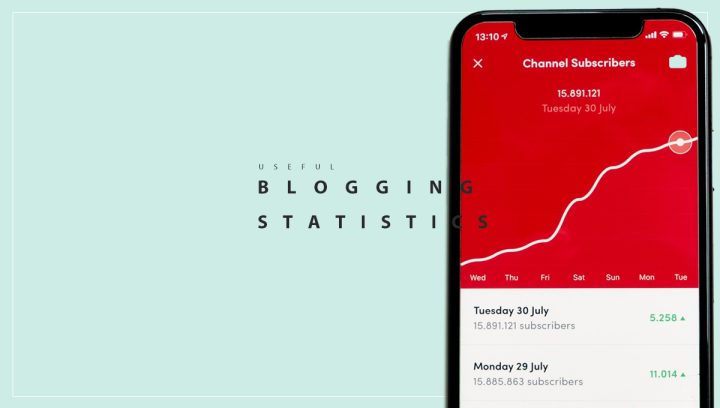In the sea of blogging statistics, there are some gems and some lumps of coal. Welcome to the treasure chest! I’ve left the coal behind so time can turn it into diamonds. Statistics are tricky little buggers. They influence the way you perceive situations, so it’s always good to go a bit deeper, to find the value behind them. I have collected and grouped all the blogging statistics you need to know, to help you get further in your blogging journey to success.
This article came about as a result of my need for an easy-to-access resource so I can find blogging statistics in one place and organized in a way that speeds up my research. I’m super excited to show you what I think are really helpful stats to pay attention to. One thing I noticed was that the high-earning bloggers place immense importance on creating good quality content for a specific target audience AND they put much effort into promoting that content once it’s published. Low-income bloggers still rely solely on organic traffic and don’t place the same importance on promotion and writing for a target audience.

Why are blogging Statistics helpful to know?
Blogging statistics help you formulate your content marketing strategy. They also give indications as to what other bloggers are doing, with and without success. As a blogger, you need to know more than just blogging statistics. You need to research your given niche. Find out what your target audience needs answers to and what they think about relevant topics.
For example, in the digital marketing niche, it’s all about the marketing but if you are a wholesale food distributor who wants to add a blog you’ll need to know the stats of the food industry. This information adds to how you’ll create campaigns based on what your target audience wants. Or if you run a fashion blog, you have to keep up with what’s trending and know how your target audience is behaving.
The blogging statistics you need to know and understand will bring clarity and reasoning to the way you curate content. Statistics deliver information based on data. Results are reached by using sample groups to gather accurate, reliable data. Conclusions are drawn and information is presented using graphs, tables, averages, and percentages.
You can use stats to help formulate business strategies and give an idea of what the competition is doing. Stats reveal the behavior and trends of a given topic or industry. But we can’t take statistics at face value. We need to look at statistics from different angles to truly benefit.
Where did the Statistics come from?
Stats are often the result of marketing surveys. Having stats to back up content sells products. Stats dress-up figures as facts. But without context, a lot gets left up to the reader’s imagination. So statistics are also used as part of marketing strategies.
Clever marketers can dress facts up in a way that attracts or convinces the buyer to make a purchase. Do they need it? Not sure, never even heard of it before. But 67% (made up number) of users say they have doubled their income so it must be something I need… Statistics inform but they also sell.
Where do you find the most articles on Blogging Statistics? Digital marketing sites and sites that sell software to bloggers and marketers. Why? Because that information is valuable and makes good content for that specific target audience.
Analytics are essential
Analytics is the most important tool a blogger can have. Only 5% of bloggers don’t use analytics. This proves how vital it is. There are many viable strategies that only a top percentage of bloggers use. And you ask yourself, why, if it works for them, is not everybody using it? Well, when it comes to analytics 95% of the blogging community have figured out it’s a must-have!
Blogging would not be what it is today without the help of analytics and digital marketing software that automates processes and drives traffic. And we wouldn’t have the stats either. So without wasting another second, let’s get knee-deep in these revealing blogging statistics you need to know!
Blogging is the most popular form of content marketing. It improves SEO and drives traffic to your site.
Let’s get started!
Blogging Statistics On A Golden Platter
I hope this post gets to serve as a handy go-to guide when you need relevant stats fast, for your future content. But first, a tidbit of food for thought.
Which sentence impresses you more?
- Business websites that add a blog see a 434% growth rate in their indexed pages, every month. (This is the official statistic on the web.)
- Business websites that add a blog see 4.34 times the amount of pages getting indexed every month. (Nowhere have I come across this stat written like this.)
This statistic is worded to sound fantastic! It indicates that business sites without a blog will not rank as high as those with a blog. Why? Because the search engine crawlers have more content which means better opportunity for keyword searches. And with crawlers picking up keywords, Google then indexes your pages for referencing when users type in certain search queries.
Bloggers are marketers. Blogging is a form of content marketing. So you need to look at stats on bloggers, marketers, and content marketing. Also, find stats for your niche. This will give insight into what your target audience is all about.
Check out our resources at the end of the article for links to reports on consumer trends and brand strategies.
Blogging Statistics for Marketers
- 72% of marketers say content creation is the most successful SEO tactic.
- 75% of marketers outsource content. Which means 25% curate their own.
- SEO leads (leads from content marketing and inbound links) have a 14.6% close rate. Compare this to a 1.7% close rate from outbound sources (like direct mail and print advertising).
- 66% of marketers use social media to promote their content.
- 65% of marketers say link building is the most difficult SEO strategy. This can be seen by the 55% of pages that have no backlinks at all.
- 70% of marketers say SEO is more effective than paid ads.
- 60% of top-ranking sites are more than 3 years old.
- 46% of all Google searches are local. This is good news for small businesses. You have more chance of success when you get ranked locally if your target audience is predominantly local.
- 18% of local smartphone searches resulted in a purchase that same day. Searches that included “nearby” or “close to me” rose by 900% in the last two years. And 72% of users, who searched locally, visited a store within 5 miles.
- Over 52% of traffic came from mobile devices.
- 61% of mobile users will visit a store close to them. And 51% will make a purchase. This shows that blogs MUST be designed for mobile devices.
More Blogging Statistics
- Businesses with blogs get double the amount of traffic from emails than businesses without blogs.
- Blogging is the easiest way to create backlinks.
- Companies with blogs get 97% more backlinks and experience a 434% growth rate.
- High-earning blogs ($50,000 +) are 5x more likely to have a podcast, 5.8x more likely to publish case studies, 4.5x more likely to publish video content, and 3.7x more likely to publish interviews.
- Quality content and link building are the top 2 factors (out of over 200) for getting ranked.
- Fast loading sites rank higher.
- Low bounce rates mean higher rankings.
- Sites that get onto the first SERP are on average 1,890 words long.
Blogging Statistics for Bloggers and Businesses with Blogs
What percentage group do you fall into?
- 24% of bloggers post weekly.
- 3% post daily.
- 66% post a few times a month, compared to a few times a week. Readers are favoring quality over quantity. And as such, posts are getting longer, and publishing them is being spread further apart.
The average post length:
- The average post length has increased by 42% over the last 5 years. The average blog post is now 1150 words long. But 18% of companies still have posts of less than 750 words.
- Blog posts of between 2,000 and 2,500 bring the best results.
- Long-form content generates 8x more views
- The average time it takes to write a blog post used to be 3.5 hours. But in the last two years, this has increased to 6 hours. (Because posts are getting longer.) 31% report positive results.
Blog post titles:
- Blog titles should ideally be between 6-13 words long. For the best SEO results, the titles are usually 11-14 words long.
- Titles with a hyphen or colon get 9% more click-through-rates (CTR).
- Titles between 6-8 words can increase CTR by 21%.
Guest posting:
- 60% of blogs publish 1-5 guest posts per month.
- 3% publish over 100 guest posts per month. (Think of sites like Medium).
- 79% of editors find guest posts too promotional.
Other:
- 34% of bloggers check their analytics regularly.
- 46% of bloggers edit their work, while 54% outsource.
- Blogs containing images get 94% more views (even with just 1 image added.)
- Only 38% of bloggers repurpose old material.
- 34% say that repurposing quality articles brings positive results.
- Blogs that use promotional techniques to drive traffic have increased by 93% over the last year.
Social media:
- 69% of bloggers use social share buttons.
- Over 95% of bloggers use social media to promote blog posts.
- 50% say it has become more difficult to get results from Facebook and almost 20% say it’s harder to get results from Google.
- This may account for the 93% increase in bloggers using promotional techniques (including paid ads) to drive traffic.
What Bloggers with high income pay attention to:
- 70% of high-earning bloggers (over $50,000 p.a) are very active in promoting their own blogs. They are 4.3x more likely to use keyword research. Compare this to low-income bloggers. Only 14% actively promote their blog content.
- High-income bloggers are 19% less interested in using social media than low-income bloggers are.
- 45% of high-income blogs sell their own product, compared to only 8% of low-earners.
- 73% of high-earners create content specifically for their target audience.
- High-earners are 2x as likely to focus on email marketing and use 343% more email collection methods than low-income bloggers.
- High-income bloggers put far more emphasis on headlines, URL, blog design, introductory paragraphs, blog names, and relationships with other bloggers and influencers than low-income bloggers.
Blogging Statistics that reveal what is happening globally
Monthly:
- 409 million people view 20 billion pages.
- WordPress users are responsible for 70 million posts.
- 77 million new comments get received.
General:
- Of 552 million blogs, 76.5 million are powered by WordPress. Over 400 million are with Tumblr.
- 66% of blog posts are written in English. 71% of WordPress blogs are written in English.
- LinkedIn is the most effective social media platform to deliver content and secure audience engagement. This may explain the drop in results from Facebook.
- Google AdSense is the most popular form of monetization, followed by affiliate marketing. But higher-income bloggers rank AdSense third, preferring to sell their product or service directly.
- Quality content is the most important factor but higher-income bloggers put great emphasis on promotion compared to low-income bloggers.
- Quality on-page SEO and content increases traffic by 2000%!
- Tumblr is responsible for over 435 million blogs, WordPress comes in at around 76.5 million.
- Two-thirds of all bloggers, blog to make money.
- Almost all bloggers say the biggest challenge is getting traffic to their sites.
- Bloggers went from 21.7 million to 31.7 million over the last two years (USA).
- 40% of millennials use voice search before making an online purchase.
- you’re 53% more likely to rank on Google with videos on your homepage and in your blog posts.
- YouTube is the second largest search engine.
- High-earning blogs say the most popular posts are 2,440 words long.
- Low-income blogs are 83% shorter than high earners.
Blogging Statistics about Users
- The average reader spends 37 seconds reading a blog.
- 47% of readers say they only skim through posts.
- 36% of readers prefer list-based headlines. For example; 25 Unique Ways To Drive Traffic: And How To Implement Them. The headline contains a number, a power word, a semi-colon, and is 11 words long.
- 17% of readers like “how-to” blog posts. This is the third most popular format.
- 77% of internet users read blogs.
- Internet users spend 3x more time reading blogs than they do checking and reading emails.
- 30% of readers say quality content makes a blog credible.
- Almost 63% of readers say blogs with guest posts are more credible.
- 59% of readers share posts without reading them. This shows how important your headline is.
- 67% of all clicks go to the first 5 organic search results.
- 70-80% of users say they ignore paid ads.
- 43% click on a site, based on the meta description.
- 75% of readers prefer reading blogs less than 1,000 words. Shorter articles are more popular but longer articles rank better.
- 61% of users say they made a purchase based on watching a vlog.
Consumer Trends
It’s super important to keep your finger on the pulse when it comes to how consumer trends have changed, especially in light of 2020’s global pandemic. So in addition to understanding what bloggers are doing, to truly get ahead you need to know what consumers are doing and get ahead of the pack. Has your blog or business got what is needed to meet the new trends?
You have the power to shape your blog accordingly. There is a huge emphasis on relationships. Consumers, B2Cs, and B2Bs all want a personalized experience. Voice search is another factor to consider as it becomes a popular way to search. As is designing content for mobile devices. And marketing to target audiences drives more traffic. Do start using images and video content more often.
I hope these blogging statistics you need to know will help you to shape your next content marketing strategy. Please feel free to ask me any questions in the comment box below. Or subscribe to our newsletter to stay informed of our latest content.
Free Resources
Some of these links require you to pay for the information. We do not get any money for promoting these pages. They are here solely for those of you interested in staying up to date on emerging consumer trends.
GWI Report
Top 10 Global Consumer Trends 2021
Fashion, Textile, Market Place Trends (for Fashion Bloggers)
PDF on fashion trends
Meltwater Market Research
Thank you to:
Growthbadger.com
Optinmonster.com
Ukwebhostreview.com
SEMrush.com
Hubspot.com
Orbitmedia.com
Contently.com
Backlinko.com
Until next time, Happy Blogging!
Monika
xxx


